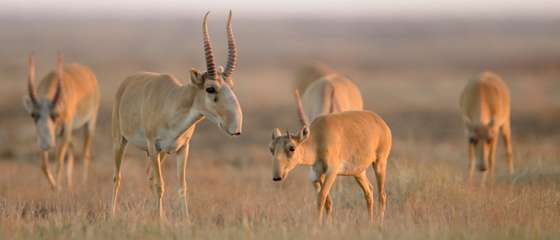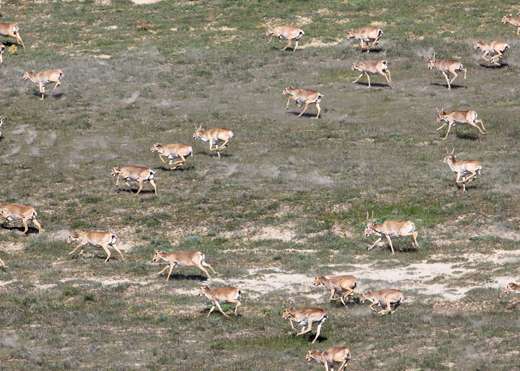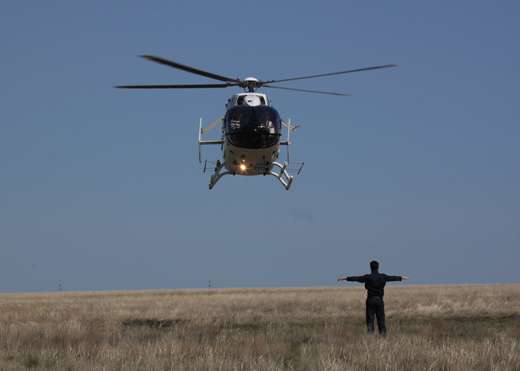Signs of hope for saiga after mass die-off

The Ministry of Agriculture of the Republic of Kazakhstan has published the results of an aerial survey of saiga, conducted in April 2016, which aimed to provide insight into the status of these beleaguered populations following last year's mass die-off.
The census data shows an increase in saiga numbers within all three populations in Kazakhstan – the saiga antelope's main range state. Experts say it is especially good news that the central Betpak-Dala population, which used to be the world's largest population, shows some signs of recovery since the die off.
Concerns for the future
In May 2015, a catastrophic mass die-off caused by a bacterial infection wiped out more than 200,000 saiga antelopes within a few weeks. The Betpak-Dala saiga population in central Kazakhstan lost almost 90% of its animals – equivalent to over 60% of the global population – leaving the species in a critical situation.
"During the mass die-off in 2015 this [Betpak-Dala] population mostly lost females and calves. Additionally poaching was on the rise, so we were very concerned about the future of this population," says Steffen Zuther, who heads the Altyn Dala Conservation Initiative (ADCI) on behalf of a group of national and international organisations and the government of Kazakhstan. Zuther and his colleagues from the Association for the Conservation of Biodiversity of Kazakhstan (ACBK) led this year's state-funded saiga census.

A glimpse of hope
In total, 36,200 adult saiga were counted in the Betpak-Dala region in central Kazakhstan during the April 2016 census – an increase in numbers since the die-off. As ACBK's Albert Salemgareyev (co-leader of the Altyn Dala Conservation Initiative) notes, "This is far below the 242,000 animals we counted in spring 2015, before the mass-die off. But we are grateful for this glimpse of hope."
The two other remaining populations within Kazakhstan also show some positive signs. One population in the European part of Kazakhstan, west of the Ural River, seems to have recovered fully from a mass die-off in 2010 and is now the largest population with more than 70,000 animals, according to this year's census.
The Ustyurt population in western Kazakhstan remains the most vulnerable of the saiga populations. Poaching had brought this population to the brink of extinction, but new data from the 2016 count revealed that a small but significant number of males survived, which allows further reproduction, and the population has not declined any further. Nevertheless saiga numbers are still at a dramatically low level with fewer than 2,000 animals counted.
"The news about recovering saiga populations in Kazakhstan is a sign of hope after the catastrophic saiga mass die-off event in 2015," said Bradnee Chambers, Executive Secretary of the Convention on Migratory Species (CMS).

"At the same time, poaching remains a serious threat to the species and we need to be aware of the fact that mass die-offs such as the one which shocked the world in 2015 can occur again and that we have still not fully understood the underlying causes of the mass die-off," said Chambers.
Conserving the Ustyurt saiga population
Fauna & Flora International (FFI) works with the Association for the Conservation of Biodiversity of Kazakhstan (ACBK) and the Kazakhstan Government to conserve the country's saiga, with activities predominantly focused on conserving the Ustyurt saiga population, which is the smallest and most at-risk from poachers who target males for their horns for use in traditional Asian medicines.
FFI and partners are working to protect saiga by monitoring their distribution and movement, training rangers and sniffer dogs to detect and deter the illegal trade of saiga horn and raising awareness within communities. In 2016, FFI plans to establish a dedicated saiga ranger team on the Ustyurt Plateau.
"Investigations into the saiga die-off are still under way, but it is clear that protecting the remaining animals from poaching will be absolutely crucial over the next few years if the species is to recover successfully," noted FFI's Eurasia Programme Director, Paul Hotham.
Provided by Fauna & Flora International


















